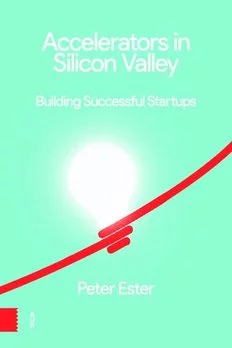
Accelerators in Silicon Valley: Building Successful Startups PDF
Preview Accelerators in Silicon Valley: Building Successful Startups
9 789462 987166 Accelerators in Silicon Valley: Building Successful Startups Accelerators in Silicon Valley: Building Successful Startups Searching for the Next Big Thing Peter Ester Amsterdam University Press This research was made possible by a grant from the Dutch Van Spaendonck Foundation. Cover design: Klaas Wijnberg Typesetting: Crius Group, Hulshout Amsterdam University Press English-language titles are distributed in the US and Canada by the University of Chicago Press. isbn 978 94 6298 716 6 e-isbn 978 90 4853 868 3 nur 800 doi 10.5117/9789462987166 © P. Ester / Amsterdam University Press B.V., Amsterdam 2017 All rights reserved. Without limiting the rights under copyright reserved above, no part of this book may be reproduced, stored in or introduced into a retrieval system, or transmitted, in any form or by any means (electronic, mechanical, photocopying, recording or otherwise) without the written permission of both the copyright owners and the authors of the book. You should start with the problem that you’re trying to solve in the world and not start with deciding that you want to build a company. Mark Zuckerberg, Facebook To all startups that contribute to a better society through their passion, ambition, and entrepreneurship Table of Contents Foreword 9 Acknowledgements 11 The Interviewees and their Accelerators 15 1 Silicon Valley 21 The DNA of an Entrepreneurial Region Introduction 21 Europe and Silicon Valley 22 Accelerators: Pillars of Silicon Valley’s startup support infra- structure 25 Accelerators: their role, research, and results 28 Methodology 32 Overview 34 2 Innovation and Startups in Silicon Valley 37 An Ecosystem Approach Modeling the Valley’s ecosystem 37 The model in more detail 40 The micro level: Product, people, and pivot 40 The meso level: Capital, universities, government, and support networks 47 The macro level: Culture, culture, culture 58 3 Unique Selling Points 63 Accelerator Philosophy, Business Model, and Cooperation Incubators versus accelerators 63 Core philosophy and focus 65 Business model 73 External cooperation 82 Conclusion 87 4 Strong Teams Will Win 89 How Accelerators Select and Coach Startup Teams Selection procedures 89 Mentoring 97 Conclusion 102 5 Working on a Dream 105 Accelerator Startup Programs General accelerators 105 Specialized accelerators 110 Accelerating platforms 114 Conclusion 116 6 Accelerator Darlings, Challenges, and Future Plans 119 Success, failure, and showcases 119 Challenges and future plans 126 Conclusion 134 7 What Can Europe Learn From Silicon Valley Accelerators? 137 Main findings and lessons 137 Bridging Europe’s innovation gap 142 The Netherlands: StartupDelta 145 Accelerator decision tool: Ten basic questions 147 Final thoughts 151 Notes 153 Glossary 159 References 165 Appendix 1 171 Silicon Valley Accelerator Founders & Chief Executives Interviewed Appendix 2 173 Questionnaire Personal Interviews Silicon Valley Accelerators Foreword Peter Ester brilliantly captures the varied but vital role that accelerators play in minting new entrepreneurs essential for economic development and new job creation in America. Based upon recommendations from various people, myself included, Peter set out on a mission to thoroughly study two dozen accelerators in Silicon Valley, the mecca of innovation. He chose the interview method with carefully defined questions in a quest to contrast his discoveries in Silicon Valley with Europe. In an easy-to-read-and-grasp style of writing, Peter does an excellent job of communicating his findings. His conclusions are descriptive and prescriptive. The target readers – whether established entrepreneurs or aspiring ones and policymakers or concerned citizens imagining new ways of economic development – are in for a treat here. Peter highlights the notion of ‘culture’ rather prominently in his analysis of critical success factors in Silicon Valley. He goes on to suggest that culture – which includes a winning mindset and the ability to take risks, try, and fail without a stigma being attached in European society– is an essential ingredient for success. What is common to all effective accelerators, Peter notes, is the existence of an ecosystem of successful role models and men- tors who are eager to offer advice and guidance to new entrepreneurs, something that is lacking in Europe. The prevalence of investors – both angels and venture capitalists – who are willing to take risks on unproven entrepreneurs is another key ingredient in Silicon Valley that is also missing in European society. I strongly encourage all success-seeking Europeans to pay close attention to what Peter Ester, a European, has to say in this book. This includes develop- ing a mindset of risk-taking that is free from stigma, stepping forward to coach and mentor others, and setting up more angels and venture capital funds. Lastly, I encourage readers to study more of Silicon Valley’s successes to build better European innovations, which in turn should lead to increased economic activity, more jobs and wealth creation, and, ultimately, better societies. Silicon Valley has stood the test of time, so it’s a very safe bet to emulate a piece of it! Vish Mishra Venture capitalist, Clearstone Venture Partners Accelerator advisor and startup mentor Former president of TiE Silicon Valley
